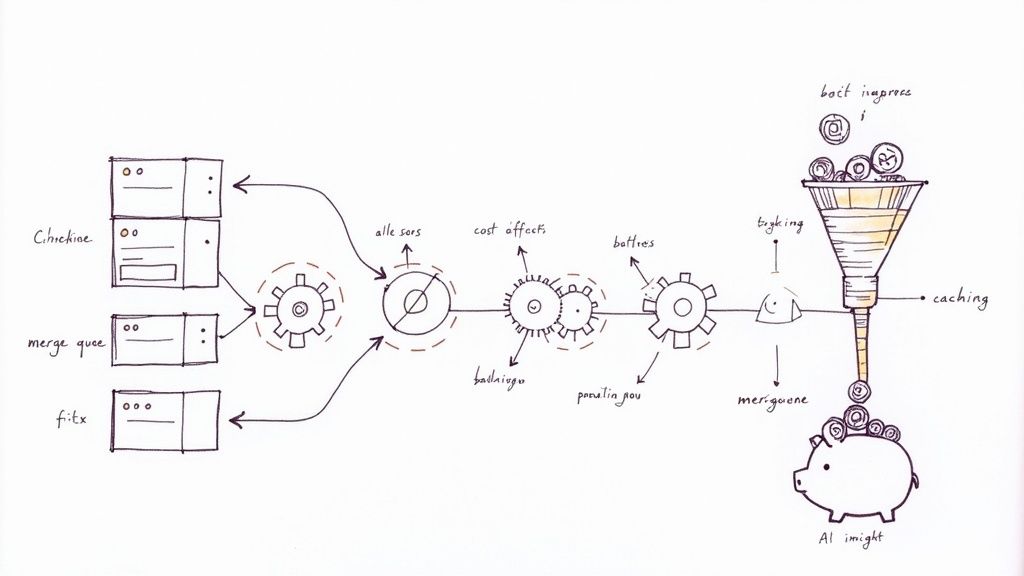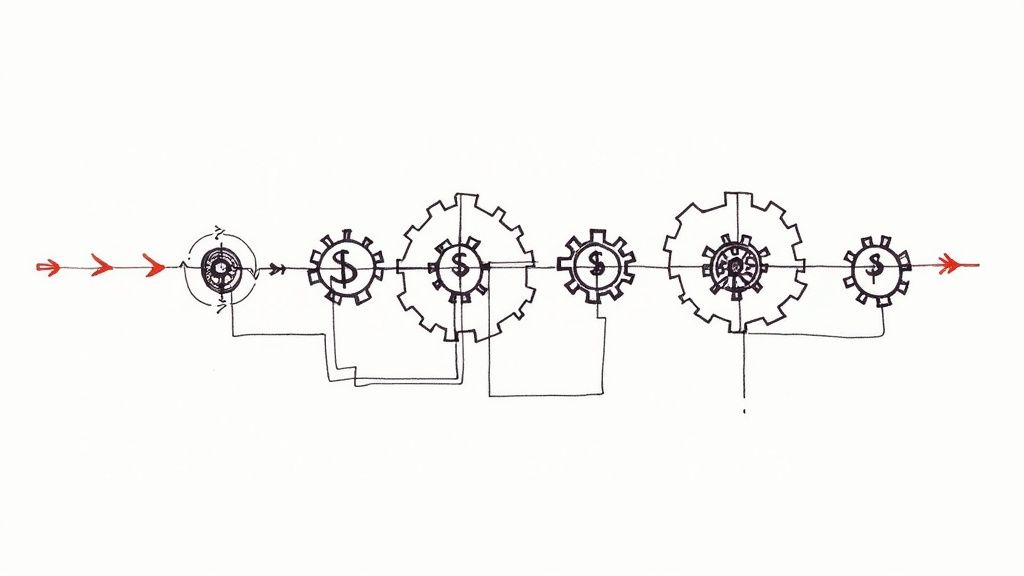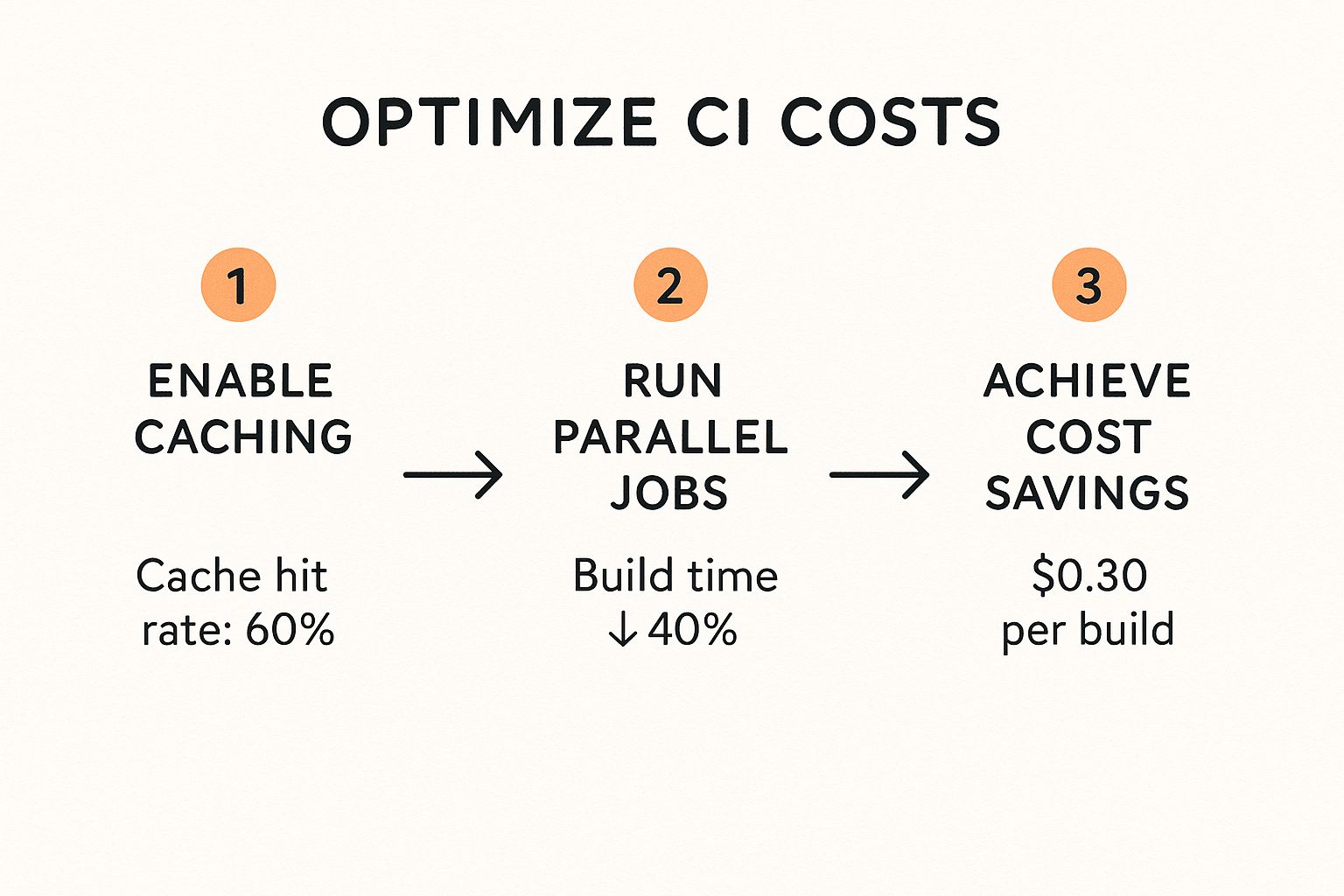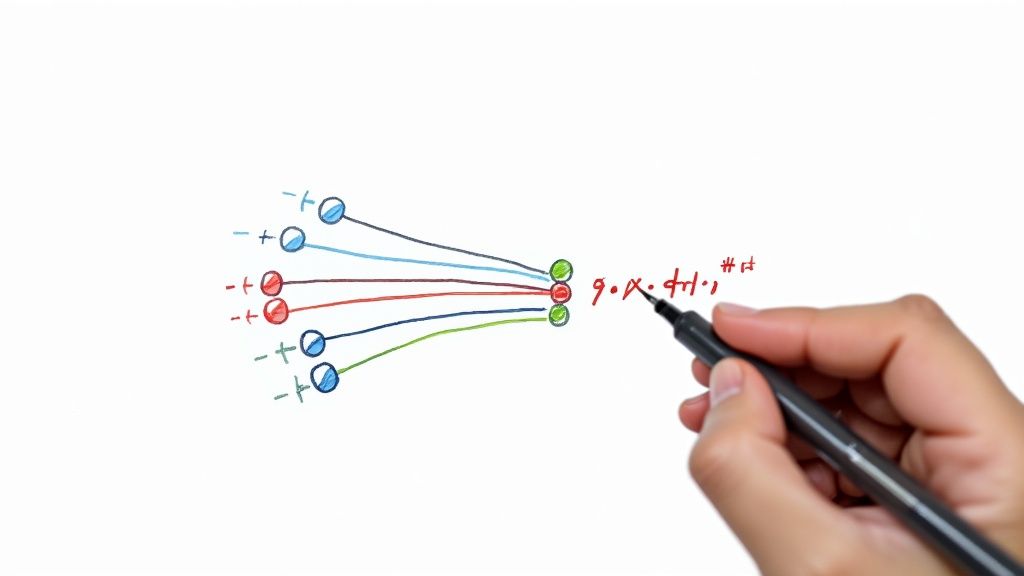A Developer's Guide to CI Cost Optimization

Let's be honest—your CI bill is probably higher than it should be. When we talk about CI cost optimization, it's easy to get tunnel vision and focus only on the server bill. But the real story is much bigger. Inefficient pipelines are notorious for draining budgets through hidden costs like developer downtime and endless context switching.
By shifting your perspective, you can stop seeing CI as just another fixed expense and start treating it like a dynamic system you can actively control.
The Real Cost of an Unoptimized CI Pipeline

When that monthly cloud invoice lands, the CI runner costs jump right out. But focusing on that number alone is like looking at the tip of the iceberg while ignoring the massive, budget-sinking block of ice underneath. The true financial hit from a poorly configured Continuous Integration pipeline is far greater, sneaking into your expenses in ways that are less obvious but far more damaging.
It's no surprise the global market for CI tools reflects this. It was valued at $2.37 billion in 2024 and is on track to hit $2.9 billion in 2025. This explosive growth shows just how vital efficient software development has become for any serious business.
Beyond Server Time: The Hidden Drains on Your Budget
The costs that really hurt are the ones you don't see on a bill. These operational inefficiencies quietly snowball, turning small annoyances into major expenses.
Here are the real culprits:
- Developer Downtime: When a developer pushes code and has to wait 20, 30, or even 45 minutes for feedback, they aren't just twiddling their thumbs. They're being pulled out of their flow state. That context switch is incredibly expensive, as it can take a long time to get back into the zone on a complex problem.
- Long Feedback Loops: Slow CI means bugs are found late. A bug caught minutes after a commit is cheap and easy to fix. One discovered hours or days later? That forces a developer to dive back into old code, drastically inflating the time and cost to resolve it.
- Wasted CI Minutes: Picture this: two developers merge their pull requests back-to-back. The CI for the second PR kicks off, but it's running against a now-stale
mainbranch. It's doomed to fail, forcing an immediate re-run. Every one of those redundant jobs is pure financial waste.
A single, long-running test suite can become a bottleneck for an entire engineering team. If it holds up ten developers for just 15 minutes a day, you're losing over two hours of productive engineering time, every single day. That cost completely dwarfs the price of the CI runner itself.
To help visualize this, here’s a quick breakdown of common pain points and how a smart tool like Mergify can solve them.
Common CI Cost Drivers and Their Solutions
This table gives a quick look at the most common CI cost centers and the Mergify strategies that directly address them, providing an immediate path to optimization.
| Cost Driver | Mergify Solution | Primary Benefit |
|---|---|---|
| Idle CI Runners | Automatic Merge Queue, PR Batching | Maximizes runner usage by processing multiple PRs at once. |
| Developer Wait Time | Speculative Checks, Optimized Queuing | Provides faster feedback and reduces context switching. |
| Redundant CI Runs | Merge Queue Logic | Ensures PRs are always tested against the latest main branch. |
| Long Feedback Loops | Prioritized Queuing, AI-Powered Insights | Surfaces critical failures faster and identifies flaky tests. |
| Unpredictable Spikes | Scheduled Merges, Queuing | Smooths out CI load, preventing costly spikes in demand. |
These solutions work together to create a more efficient, predictable, and cost-effective CI process, turning a major cost center into a streamlined asset.
A Scenario of Spiraling Costs
Imagine a team with a pipeline that takes 40 minutes to complete. A developer submits a pull request and, not wanting to waste time, moves on to another task. Forty minutes later, the build fails because of a minor conflict. Now, the developer has to stop what they're doing, switch contexts, and figure out what went wrong.
This frustrating cycle can easily turn a simple merge into a half-day affair.
Now, multiply that by several developers, and the pipeline becomes a constant source of delays and frustration. It directly torpedoes your team’s velocity and your ability to ship features. This is where active CI cost optimization with tools like Mergify isn't just a "nice-to-have"—it's essential.
To get a broader view on reining in cloud expenses, it's worth exploring strategies for effective Cloud Cost Optimization That Actually Saves Money. In the sections that follow, we'll dive into exactly how you can use Mergify to reclaim both your team's time and your budget.
Slash Your Bill with Intelligent Batch Processing
When it comes to high-impact, low-effort CI cost optimization, nothing really beats batch processing. It’s the one strategy that can deliver the biggest and fastest savings by fundamentally rethinking how you run your tests. Instead of kicking off a separate, costly CI job for every single pull request, you can intelligently group them together to run just one, comprehensive test suite.
This approach immediately gets to the heart of CI resource contention and waste. Picture this: instead of ten developers competing for ten CI runners, Mergify’s batching feature consolidates their pull requests into a single unit, executing one job. That simple shift can drastically cut down on your CI minutes, which you'll see reflected directly on your monthly bill.
How Batch Processing Works in Practice
Let’s imagine a busy repository where several developers are pushing changes around the same time. In a typical setup, each new PR triggers a full CI run. If five PRs are ready within a few minutes of each other, you're on the hook for five separate CI jobs. That adds up fast.
With Mergify, you can set rules to batch these PRs together. It will wait for a short, configurable period or until a certain number of PRs are ready, group them, and then run the CI checks just once on all the combined code. If the tests pass, every PR in that batch gets merged simultaneously.
Here’s what that looks like right inside the Mergify interface—multiple pull requests neatly grouped into a single batch, ready for a single test run.
This screenshot really shows the power of batching in action. Three separate pull requests are consolidated, saving us from running (and paying for) two entire CI jobs. What you get is a much more orderly, efficient, and cost-effective merge process.
Configuring Your First Batch
Getting batch processing up and running is surprisingly straightforward. All it takes is adding a few lines to your .mergify.yml file to tell Mergify how you want to group your pull requests. You can control the batch size and the maximum time a PR will wait before a batch is formed.
For a project with a steady flow of contributions, you might configure Mergify to create a batch of up to five pull requests or to trigger a run every 10 minutes—whichever comes first. This ensures you’re always processing PRs efficiently without making developers wait too long.
Here’s a practical configuration to get you started:
queue_rules:
- name: default conditions:
- "#approved-reviews-by>=1"
- "status-success=Travis CI - Pull Request" speculative_checks: 5 batch_size: 5
This setup creates batches of up to five pull requests and is a solid starting point for many teams. To see how this fits into a broader CI/CD strategy, check out our guide on continuous integration best practices.
The Financial Impact of Batching
Let's break down the savings with a clear, real-world scenario.
| Metric | Without Batching (10 PRs) | With Batching (10 PRs in one batch) |
|---|---|---|
| Number of CI Jobs | 10 | 1 |
| CI Job Duration | 15 minutes | 18 minutes (slightly longer for more tests) |
| Total CI Time | 150 minutes | 18 minutes |
| Cost (at $0.08/minute) | $12.00 | $1.44 |
In this example, intelligent batching delivers an 88% cost reduction for the exact same set of pull requests. The savings scale directly with the volume of contributions your repositories see.
This focus on sustainable savings isn't just a nice-to-have; it's becoming a core business strategy. The FinOps market, a field dedicated to cloud cost optimization, is valued at $5.5 billion and is expected to grow at a CAGR of 34.8% from 2023 to 2025. That growth tells you everything you need to know about how seriously organizations are taking this. By adopting batching, you're putting a core FinOps principle directly into your development workflow.
Optimize CI Usage with a Speculative Merge Queue
While batching is a fantastic way to get a quick win on CI costs, a merge queue represents a more fundamental, and I'd argue more powerful, shift in how your team merges code. It's about moving from a reactive, often chaotic process to a proactive and orderly workflow. This change directly tackles one of the biggest—and most frustrating—sources of wasted CI spend: redundant builds.
Let's be honest, the traditional merge process is inherently inefficient. When multiple pull requests are ready to go, it becomes a race. Developers scramble to get their PR merged first. The winner gets in, but every other PR is now technically based on a stale main branch. This forces everyone else to rebase and re-run their entire CI pipeline, burning through CI minutes and, more importantly, developer time.
The Power of Speculative Checks
This is where a Mergify Merge Queue with speculative checks completely changes the game. Instead of waiting for one PR to fully merge before even looking at the next, the queue gets ahead of the problem. It proactively tests pull requests in a combined, future state.
Here’s a breakdown of how it works in practice:
- PR 1 enters the queue. Mergify kicks off the CI checks on it, just as you'd expect.
- PR 2 enters right after. Now, instead of waiting, Mergify creates a temporary branch that combines the changes from both PR 1 and PR 2. It runs the CI checks on this speculative branch.
- PR 3 joins the line. Mergify does it again, testing a new speculative branch that includes the combined changes of PR 1, PR 2, and PR 3.
If all these speculative runs pass, Mergify merges the entire series of pull requests into the main branch in one smooth operation. The real magic here? You never waste a single CI run on a stale branch again. Every test is performed against the most up-to-date version of your codebase possible at that moment.
By testing pull requests against a future, combined state of the main branch, a speculative merge queue ensures that CI resources are only used for builds that are guaranteed to be relevant. This single change can eliminate countless failed builds caused by merge conflicts and outdated codebases.From Chaos to Order: A Real-World Comparison
To really see the difference, let’s contrast the two workflows. It’s a night-and-day experience for any development team.
| Traditional Merge Process (The Chaos) | Mergify Merge Queue (The Order) |
|---|---|
| Developers manually race to merge PRs. | PRs are automatically added to an orderly queue. |
| Frequent "merge and rebase" cycles. | The queue handles updates and re-testing automatically. |
High potential for merge conflicts and a broken main branch. |
The main branch is always protected and stable. |
| CI runs are often wasted on stale code. | Speculative checks ensure every CI run is meaningful. |
| Unpredictable and frustrating for developers. | Provides a predictable, fair, first-in-first-out process. |
This process flow visualizes how different optimization techniques, including the caching and parallelism that work so well alongside a merge queue, all add up to some serious cost savings.

The visualization maps out a clear path from enabling features like caching to achieving real, tangible reductions in build times and per-build costs.
Configuring Your Merge Queue for Maximum Savings
Getting a merge queue running in Mergify is straightforward—it’s all handled right in your .mergify.yml file. Here, you define the rules that determine which pull requests enter the queue and how they should be handled. For a much deeper look at optimizing your entire pipeline, we've put together a comprehensive guide on CI/CD pipeline optimization.
Here’s a practical example of what a merge queue configuration using speculative checks looks like:
queue_rules:
- name: default conditions:
- "#approved-reviews-by>=1"
- "status-success=lint"
- "status-success=tests" speculative_checks: 5
This simple config creates a queue named default. A pull request gets added once it has at least one approved review and both the lint and tests checks are green. That speculative_checks: 5 line is the key—it tells Mergify to test up to five pull requests ahead in the queue. This maximizes your CI cost optimization by validating a deep pipeline of upcoming changes all at once.
By bringing a merge queue into your workflow, you’re doing more than just cutting costs. You’re building a more resilient, efficient, and developer-friendly engineering culture. It’s a strategic move that pays dividends in both your budget and your team’s productivity.
Implement Smart Caching and Scheduled Workflows

Beyond batching and queues, a couple of my favorite tactics for cutting down CI costs are smart caching and scheduled workflows. The idea behind both is simple: stop doing unnecessary work, especially when your CI runners are in high demand and costing you the most.
Think of caching as giving your CI pipeline a memory. Instead of rebuilding everything from scratch on every single run, it can grab components from previous jobs. Scheduling, on the other hand, is just smart time management—pushing non-urgent jobs to times when resources are cheap and plentiful.
Identifying Prime Candidates for Caching
To really get your money's worth out of caching, you have to find the parts of your build process that are slow, repetitive, and don't change very often. These are your low-hanging fruit.
Some excellent targets for caching include:
- Package Dependencies: This is a big one. Think
node_modules,pippackages, or Maven dependencies. These rarely change between commits but can take several minutes to download and install. Caching them is an easy win. - Docker Layers: If you build Docker images in your CI pipeline, caching the intermediate layers is a massive time-saver. It keeps the system from rebuilding the entire image from the ground up just for a tiny code change.
- Build Artifacts: Compiled binaries, test databases, or other assets that you generate in one stage and use in another are perfect for caching. You avoid regenerating the exact same files over and over.
Configuring Caching with Mergify and GitHub Actions
While Mergify is great at managing when your CI runs, the actual caching configuration happens within your CI provider. Let's walk through a common example using GitHub Actions, triggered by a simple Mergify rule.
Your Mergify setup might just be a standard rule to queue up CI checks:
pull_request_rules:
- name: run CI on every push conditions:
- base=main actions: queue: name: default
The magic happens in your GitHub Actions workflow file, .github/workflows/ci.yml. You just add the caching action. This tells GitHub to save the node_modules directory, using a hash of your package-lock.json file as the key. If that lock file hasn't changed, the cache is restored almost instantly.
- name: Cache Node.js modules uses: actions/cache@v3 with: path: ~/.npm key: ${{ runner.os }}-node-${{ hashFiles('**/package-lock.json') }} restore-keys: | ${{ runner.os }}-node-
This one small addition can easily shave 2-5 minutes off each job. Across hundreds of builds a month, the savings really start to add up.
Scheduling Non-Critical Workflows
Let's be honest, not all CI jobs are created equal. Unit tests on a new feature? That needs immediate feedback. But running exhaustive linting checks, building documentation, or generating performance reports? Those are far less urgent.
Running these non-critical jobs during peak development hours consumes valuable CI resources that could be used for pull requests that are actively blocking developers. The goal is to shift this workload to off-peak hours.
This is a perfect use case for Mergify's scheduled triggers. For instance, you can set up a rule to run your documentation build just once a night instead of on every single commit.
Here’s a Mergify rule that triggers a GitHub Actions workflow named docs-build every day at 3 AM:
scheduled_jobs:
- name: nightly documentation build actions: trigger: workflow: docs-build.yml conditions:
- schedule=0 3 * * *
This approach is a cornerstone of automating repetitive tasks for better workflow. It frees up your CI runners during the workday for the stuff that matters most, ensuring developers get fast feedback when they need it. By combining smart caching with intelligent scheduling, you create a powerful system for CI cost optimization that cuts waste without compromising on quality or speed.
4. Let AI Supercharge Your Pipeline Optimization

Batching, queues, and caching are fantastic for refining the structure of your CI workflow. But the real game-changer? Making the workflow itself more intelligent. This is where AI comes in, completely shifting how we think about testing and pipeline efficiency.
Instead of running every pull request through the same rigid, one-size-fits-all process, AI lets you analyze code changes on the fly and make smarter decisions. This isn’t some far-off future concept; with Mergify, you can start doing this today.
Slash Test Runtimes with AI-Powered Test Impact Analysis
Let’s be honest: for most teams, the test suite is the single most expensive part of the CI pipeline. Running the entire suite for a minor documentation typo is a colossal waste of compute time and money. This is precisely where AI delivers its biggest cost-saving punch: test impact analysis.
Mergify’s AI digs into the code inside a pull request to understand what it actually does. It figures out which parts of the application are affected and then determines the exact subset of tests that need to run. No more running thousands of tests for a one-line CSS tweak.
Picture this: a developer pushes a small fix to a UI component. The AI sees the change only touches the front end and tells the CI system to only run the relevant Cypress tests. It skips all the time-consuming back-end integration and database tests. A 40-minute test run can instantly become a 5-minute one.
By intelligently selecting only the necessary tests, AI-driven analysis directly attacks the largest CI cost center for many teams. This isn’t just about skipping tests; it’s about running the right tests, every single time, ensuring both safety and efficiency.
If you want to get better at spotting these kinds of performance drains, check out our guide on CI monitoring best practices.
Speed Up Human Reviews with AI-Generated Summaries
CI costs aren't just about machine time; developer time is just as valuable. A pull request sitting idle, waiting for a human review, is a bottleneck that holds up the entire team and keeps CI resources locked. Mergify’s AI helps here, too, by speeding up the human side of the equation.
It automatically generates clear, concise summaries for pull requests. This gives reviewers immediate context, so they don't have to wade through every line of code just to understand the purpose of the change.
Here’s how AI gives your review process a boost:
- Better PR Titles: The AI suggests descriptive titles, making your PR list easier to scan and prioritize.
- Quick Summaries: It writes a short, human-readable summary of the changes, highlighting the important stuff.
- Faster Onboarding: A reviewer who’s unfamiliar with a part of the codebase can get up to speed in seconds.
All of this accelerates the entire review-test-merge cycle. When reviews happen faster, pull requests spend less time in limbo, freeing up CI runners and letting your developers get back to building what's next.
The Undeniable ROI of AI in Your Pipeline
Bringing AI into your CI/CD process isn't just a cool tech demo; it's a strategic move with a very clear return on investment. The benefits quickly create a powerful feedback loop of savings and efficiency.
| AI-Driven Feature | Direct Cost Impact | Indirect Productivity Impact |
|---|---|---|
| Test Impact Analysis | Drastically reduces CI runner minutes and associated costs. | Developers get feedback faster, reducing context switching. |
| PR Summaries | Shortens the time a PR occupies a CI slot in a queue. | Reviewers can approve PRs more quickly and confidently. |
| Infrastructure Insights | Identifies flaky tests or infrastructure bottlenecks automatically. | Reduces time spent on manual debugging of the CI system. |
This shift toward smarter automation is happening across the industry. To make a real dent in development and CI costs, it's worth exploring emerging AI software engineer tools that can automate even more engineering tasks. By putting a tool like Mergify at the heart of your workflow, you're building an intelligent system that optimizes for both time and money, giving your team a real competitive edge.
Your Questions on CI Cost Optimization Answered
Diving into CI cost optimization always brings up a ton of questions. As engineering teams start exploring batching, merge queues, and AI-driven testing, practical concerns and "what-if" scenarios naturally pop up.
We’ve heard them all. Here are the most common sticking points we hear from developers and engineering managers, with direct, actionable answers drawn from real-world experience.
Will Batching Pull Requests Slow Down My Team's Velocity?
This is easily the #1 concern we get, but the reality is almost always the opposite. While it seems counterintuitive, batching pull requests usually increases your team's overall throughput and gets code shipped faster.
It’s all about looking at the big picture. Sure, a single pull request in a batch might wait a few extra minutes for its tests to kick off. But by grouping PRs together, you slash the total time your team spends stuck in line waiting for a CI runner. That trade-off is a massive net win.
Think about the alternative. Ten developers push their PRs around the same time. In a one-by-one world, they form a queue, and the last developer might wait an hour or more just for their turn. With batching, all ten PRs can be tested and merged in a single, slightly longer CI run. The queue is gone.
The real win isn't just about saving money; it's about creating a more predictable and rhythmic merge cycle. Developers spend less time context-switching while waiting for CI, which translates to a clear gain in velocity, not a loss.
And Mergify's batching is completely tunable. You can set a maximum wait time (like 5 minutes) or a max batch size (like 5 PRs) to find the sweet spot for your team's rhythm. This gives you all the efficiency of batching without ever making developers feel like they're being held back.
How Do I Find My Most Expensive CI Jobs?
Pinpointing your biggest cost drivers is the essential first step for any real CI cost optimization. The good news is that most CI providers make this information pretty easy to track down.
Here’s where to start digging:
- Your CI Provider's Dashboard: Head straight to the analytics or billing section in GitHub Actions, CircleCI, or GitLab CI. They usually have detailed breakdowns of job runtimes and resource usage.
- Look for Duration and Frequency: Hunt for the jobs with the longest runtimes. A job that takes 30 minutes is an obvious target. Don't forget to look at jobs that run very frequently, too—even short, repetitive jobs add up fast.
- Identify Common Culprits: End-to-end (E2E) tests, complex build processes, and heavy integration tests are the usual suspects. These are prime candidates for optimization.
Once you have your list, you can apply the strategies we've covered. Can you cache their dependencies? Run them on a schedule instead of every commit? Or, even better, use Mergify's AI-powered test impact analysis to only run the tests a change actually affects? This surgical approach is far more effective than trying to boil the ocean.
Is a Merge Queue Overkill for a Small Team?
Not at all. While merge queues are famous for taming merge chaos on massive projects, their CI cost optimization benefits are just as crucial for smaller teams. For a team of two to five engineers, the main win isn’t just about stopping conflicts—it’s about eliminating the pure financial waste of redundant CI runs.
Consider this everyday scenario, even with just two developers:
- Developer A's PR passes all its checks and is ready to merge.
- Developer B's PR also passes its checks around the same time.
- Developer A merges first.
- Now, Developer B's PR is technically based on an out-of-date
mainbranch. Merging it is a gamble that could break the build.
Without a merge queue, the only "safe" move is for Developer B to rebase their branch and re-run the entire CI pipeline from scratch. That's a complete waste of a CI run. A merge queue with speculative checks stops this dead in its tracks by testing PRs sequentially against the absolute latest version of the code before the merge happens. Every CI run counts.
For a small team, saving just a few of these redundant builds a day adds up to big savings in CI minutes and, more importantly, keeps your developers in the flow.
What Is the First Step I Should Take?
Implement batch processing. It is, without a doubt, the simplest and most impactful first move you can make on your CI cost optimization journey.
It delivers immediate, measurable savings by dramatically cutting down the number of CI jobs you run. Unlike setting up complex caching or refactoring test suites, batching is a high-level workflow change that only takes a few lines in your .mergify.yml file.
You don't need to dig into build scripts or understand the nuances of a dependency tree. You're just telling Mergify to be smarter about when it triggers your existing CI workflow.
My advice? Start small. Enable batching on a low-risk repository and see the impact for yourself. Watch how it smooths out the CI workload and shrinks queue times. Once you see the numbers, you'll have all the confidence you need to roll it out to your most active and expensive projects. It’s the lowest-hanging fruit with the biggest reward.
Ready to stop wasting money on inefficient CI pipelines? Mergify provides the tools you need—from intelligent batching and merge queues to AI-powered optimization—to take control of your costs and free your developers to do what they do best. Start optimizing with Mergify today.





